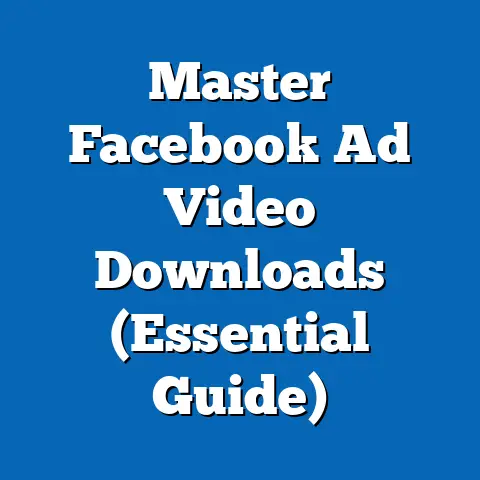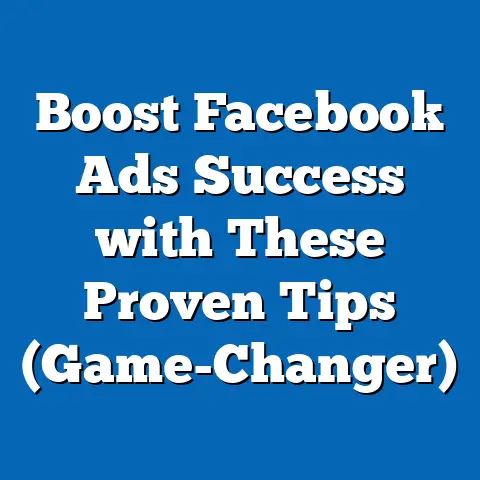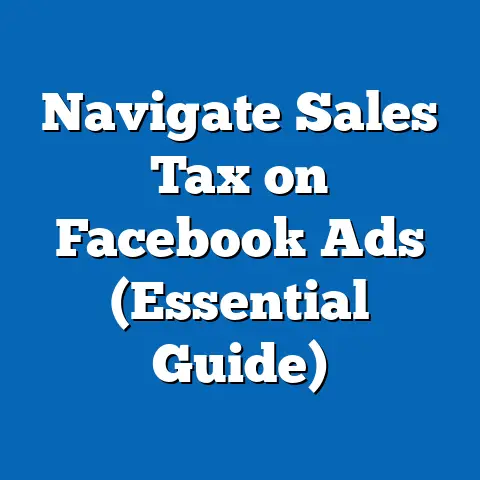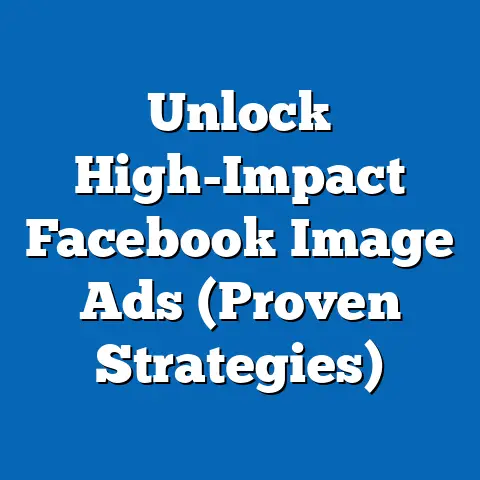Mastering fb ad Pauses (Pro Strategies for Maximum ROI)
Mastering Facebook Ad Pauses: Pro Strategies for Maximum ROI
Why did the marketer break up with the calendar? Because it had too many dates! Joking aside, when it comes to Facebook advertising, many believe that the key to success lies in consistently running ads, day in and day out. But what if I told you that one of the most powerful, yet often overlooked, strategies is knowing when to pause those ads?
Facebook ads are a cornerstone of modern digital marketing, allowing businesses to reach vast audiences with targeted messaging. However, simply setting up an ad and letting it run indefinitely can lead to wasted ad spend and diminishing returns. Strategic ad pauses can significantly boost your ROI, allowing you to optimize your campaigns for maximum impact.
In this article, I’ll walk you through the art of mastering Facebook ad pauses. We’ll cover everything from understanding what ad pauses are and why they’re important, to identifying the right moments to hit that pause button, and implementing pro-level strategies. By the end, you’ll have the knowledge and tools to make informed decisions that drive better results from your Facebook advertising efforts.
Understanding Facebook Ad Pauses
Let’s start with the basics: what exactly is an ad pause? In the Facebook Ads Manager, pausing an ad simply means temporarily stopping it from running. This action prevents your ad from being shown to your target audience and, crucially, stops you from incurring further costs.
Why Pause Your Ads?
There are several compelling reasons why advertisers might choose to pause their Facebook ads. Here are a few of the most common:
- Budget Constraints: Maybe you’ve allocated a specific budget for a campaign, and you’ve reached your limit sooner than expected. Pausing allows you to avoid overspending.
- Performance Issues: If your ad is underperforming – low engagement, high costs, poor conversion rates – pausing gives you a chance to analyze the data and make necessary adjustments.
- Seasonal Relevance: Some products or services are only relevant during certain times of the year. Pausing ads during the off-season prevents wasted spend.
- Inventory Issues: Imagine running an ad promoting a product that suddenly goes out of stock. Pausing the ad prevents frustrating potential customers.
- Testing and Optimization: Pausing ads can be part of a structured A/B testing strategy, allowing you to compare different ad variations and identify the best performers.
- External Factors: Sometimes, external events (like a major news story or a crisis) can make your ad messaging seem tone-deaf or irrelevant. Pausing allows you to be sensitive to the current climate.
ROI: The Bottom Line
The ultimate goal of any advertising campaign is to generate a positive return on investment (ROI). ROI is calculated as the profit generated from your ad spend divided by the cost of the ad. Pausing ads strategically is directly tied to improving your ROI. By stopping ads that are bleeding money and optimizing those that are performing well, you can ensure that every dollar you spend is working hard for you.
Think of it like this: you wouldn’t keep pouring water into a leaky bucket, would you? Similarly, you shouldn’t keep spending money on ads that aren’t delivering results. Pausing allows you to plug the leaks and focus on filling the bucket with profitable conversions.
Takeaway: Ad pauses are a crucial tool for managing your Facebook ad campaigns effectively. They allow you to control your budget, optimize performance, and ultimately, maximize your ROI.
When to Pause Your Facebook Ads
Knowing when to pause your ads is just as important as knowing why. Here are some key indicators that signal it’s time to consider hitting that pause button:
-
Low Engagement Rates: If your ad is generating very few likes, comments, shares, or clicks, it’s a sign that your target audience isn’t resonating with your message.
- How to interpret it: Compare your engagement rates to industry benchmarks. A low engagement rate could indicate problems with your ad creative, targeting, or offer.
- Relates to: Click-Through Rate (CTR), Relevance Score. Low engagement will likely lead to a low CTR and a poor Relevance Score.
-
High Cost Per Click (CPC) or Cost Per Acquisition (CPA): If you’re paying significantly more than your target CPC or CPA, it’s a red flag.
- How to interpret it: Monitor your CPC and CPA regularly. If they start to creep up, it’s time to investigate.
- Relates to: Conversion Rate, Budget. A high CPC/CPA can quickly deplete your budget if your conversion rate isn’t strong enough.
-
Poor Conversion Rates: If people are clicking on your ad but not completing the desired action (e.g., making a purchase, filling out a form), your conversion rate is suffering.
- How to interpret it: Track your conversion rate closely. A sudden drop could indicate issues with your landing page, checkout process, or offer.
- Relates to: Return on Ad Spend (ROAS). A low conversion rate directly impacts your ROAS.
-
Relevance Score Decline: Facebook’s Relevance Score measures how well your ad resonates with your target audience. A low score indicates that your ad is not relevant, leading to higher costs and lower reach.
- How to interpret it: Keep an eye on your Relevance Score. A score below 5 is a cause for concern.
- Relates to: Engagement Rate, CTR. A low Relevance Score often correlates with low engagement and CTR.
-
Frequency Issues: If your ad is being shown to the same people too many times, it can lead to ad fatigue and decreased performance.
- How to interpret it: Monitor your ad frequency. A frequency above 3 or 4 can be a sign that your audience is getting tired of seeing your ad.
- Relates to: Engagement Rate, CTR. High frequency can lead to lower engagement and CTR as people become desensitized to your ad.
Low Engagement Rates: If your ad is generating very few likes, comments, shares, or clicks, it’s a sign that your target audience isn’t resonating with your message.
- How to interpret it: Compare your engagement rates to industry benchmarks. A low engagement rate could indicate problems with your ad creative, targeting, or offer.
- Relates to: Click-Through Rate (CTR), Relevance Score. Low engagement will likely lead to a low CTR and a poor Relevance Score.
High Cost Per Click (CPC) or Cost Per Acquisition (CPA): If you’re paying significantly more than your target CPC or CPA, it’s a red flag.
- How to interpret it: Monitor your CPC and CPA regularly. If they start to creep up, it’s time to investigate.
- Relates to: Conversion Rate, Budget. A high CPC/CPA can quickly deplete your budget if your conversion rate isn’t strong enough.
Poor Conversion Rates: If people are clicking on your ad but not completing the desired action (e.g., making a purchase, filling out a form), your conversion rate is suffering.
- How to interpret it: Track your conversion rate closely. A sudden drop could indicate issues with your landing page, checkout process, or offer.
- Relates to: Return on Ad Spend (ROAS). A low conversion rate directly impacts your ROAS.
Relevance Score Decline: Facebook’s Relevance Score measures how well your ad resonates with your target audience. A low score indicates that your ad is not relevant, leading to higher costs and lower reach.
- How to interpret it: Keep an eye on your Relevance Score. A score below 5 is a cause for concern.
- Relates to: Engagement Rate, CTR. A low Relevance Score often correlates with low engagement and CTR.
Frequency Issues: If your ad is being shown to the same people too many times, it can lead to ad fatigue and decreased performance.
- How to interpret it: Monitor your ad frequency. A frequency above 3 or 4 can be a sign that your audience is getting tired of seeing your ad.
- Relates to: Engagement Rate, CTR. High frequency can lead to lower engagement and CTR as people become desensitized to your ad.
Analyzing Ad Performance Metrics
Making informed decisions about pausing ads requires a deep dive into your ad performance metrics. Here’s a quick rundown of the key metrics to watch:
- Impressions: The number of times your ad was shown.
- Reach: The number of unique people who saw your ad.
- Click-Through Rate (CTR): The percentage of people who saw your ad and clicked on it.
- Cost Per Click (CPC): The amount you pay each time someone clicks on your ad.
- Conversions: The number of desired actions taken as a result of your ad (e.g., purchases, leads).
- Cost Per Acquisition (CPA): The amount you pay for each conversion.
- Return on Ad Spend (ROAS): The revenue generated for every dollar spent on advertising.
- Relevance Score: Facebook’s rating of how relevant your ad is to its target audience.
Scenario Examples
Let’s look at a few examples of scenarios where pausing ads can prevent financial loss:
- Example 1: You’re running an ad campaign to promote a new product launch. After a week, you notice that your CPC is unusually high, and your conversion rate is abysmal. Pausing the ad allows you to reassess your targeting, ad creative, and landing page to identify the problem.
- Example 2: You’re running a seasonal promotion for summer clothing. As summer ends, you notice a significant drop in engagement and conversions. Pausing the ad prevents you from wasting money on an audience that’s no longer interested.
- Example 3: You’re running an A/B test with two different ad variations. After a few days, one ad clearly outperforms the other. Pausing the underperforming ad allows you to focus your budget on the winner.
Takeaway: Regularly monitoring your ad performance metrics is essential for identifying when it’s time to pause your ads. By analyzing the data and understanding the underlying reasons for poor performance, you can make informed decisions that protect your budget and improve your ROI.
Pro Strategies for Effective Ad Pausing
Now that you understand the importance of ad pauses and when to consider them, let’s dive into some pro-level strategies for making the most of this powerful tool.
-
A/B Testing and Experimentation:
A/B testing involves running two or more versions of an ad simultaneously to see which one performs better. Pausing is a crucial part of this process.
- How to use pauses effectively: Start by creating two variations of your ad, changing only one element at a time (e.g., headline, image, call to action). Run both ads for a set period (e.g., 3-7 days) and then analyze the results. Pause the underperforming ad and continue running the winner.
- Tips for analyzing test results: Focus on key metrics like CTR, CPC, and conversion rate. Use statistical significance to determine whether the difference in performance between the two ads is meaningful.
- My Experience: I once ran an A/B test where I simply changed the color of the call-to-action button on my ad. To my surprise, the ad with the green button outperformed the ad with the blue button by over 20% in terms of conversion rate. Pausing the blue button ad allowed me to focus my budget on the higher-performing green button ad.
-
Utilizing Ad Scheduling:
Ad scheduling allows you to run your ads only during specific times of the day or days of the week. This can be particularly effective if you know when your target audience is most active on Facebook.
- Benefits of scheduling ads: By running ads only during peak performance times, you can increase your engagement rates and lower your costs.
- How to identify peak performance times: Use Facebook Audience Insights to analyze your target audience’s behavior. You can see when they’re most active on Facebook and tailor your ad schedule accordingly.
- Example: If you’re targeting working professionals, you might find that they’re most active on Facebook during their lunch breaks and after work hours. Scheduling your ads to run during these times could lead to better results.
- My Experience: I once worked with a restaurant that was struggling to attract customers during off-peak hours. By using ad scheduling, we were able to target people in the local area with special offers during those slow periods, resulting in a significant increase in foot traffic.
-
Retargeting and Re-engagement:
Retargeting involves showing ads to people who have previously interacted with your business (e.g., visited your website, watched a video, engaged with your Facebook page). Pausing underperforming ads and retargeting the audience with fresh content can be a powerful strategy.
- How to pause and retarget: If you notice that a retargeting ad is underperforming, pause it and create a new ad with a different message or offer. Experiment with different ad formats and targeting options to see what resonates best with your audience.
- Strategies for re-engaging users: Offer a discount or incentive to encourage people to take action. Use compelling visuals and persuasive copy to capture their attention.
- Example: If someone visited your website but didn’t make a purchase, you could retarget them with an ad offering a free shipping code or a limited-time discount.
- My Experience: I once ran a retargeting campaign that was initially underperforming. After pausing the ad and creating a new version with a more personalized message and a stronger call to action, I saw a dramatic increase in conversion rates.
-
Seasonal Adjustments:
Many businesses experience seasonal fluctuations in demand. Pausing ads during off-peak seasons and launching targeted campaigns during peak seasons is a smart way to optimize your ad spend.
- Importance of pausing during off-peak seasons: Running ads for summer clothing in the winter is likely to be a waste of money. Pausing those ads allows you to focus your budget on more relevant campaigns.
- Benefits of seasonal campaigns: Launching targeted campaigns during holidays or other special events can drive significant sales.
- Examples of industries where seasonality plays a crucial role: Retail, travel, hospitality, and event planning are all industries where seasonality is a major factor.
- My Experience: I once worked with a ski resort that was running ads year-round. By pausing the ads during the summer months and focusing on targeted campaigns during the winter, we were able to significantly increase their ROI.
A/B Testing and Experimentation:
A/B testing involves running two or more versions of an ad simultaneously to see which one performs better. Pausing is a crucial part of this process.
- How to use pauses effectively: Start by creating two variations of your ad, changing only one element at a time (e.g., headline, image, call to action). Run both ads for a set period (e.g., 3-7 days) and then analyze the results. Pause the underperforming ad and continue running the winner.
- Tips for analyzing test results: Focus on key metrics like CTR, CPC, and conversion rate. Use statistical significance to determine whether the difference in performance between the two ads is meaningful.
- My Experience: I once ran an A/B test where I simply changed the color of the call-to-action button on my ad. To my surprise, the ad with the green button outperformed the ad with the blue button by over 20% in terms of conversion rate. Pausing the blue button ad allowed me to focus my budget on the higher-performing green button ad.
Utilizing Ad Scheduling:
Ad scheduling allows you to run your ads only during specific times of the day or days of the week. This can be particularly effective if you know when your target audience is most active on Facebook.
- Benefits of scheduling ads: By running ads only during peak performance times, you can increase your engagement rates and lower your costs.
- How to identify peak performance times: Use Facebook Audience Insights to analyze your target audience’s behavior. You can see when they’re most active on Facebook and tailor your ad schedule accordingly.
- Example: If you’re targeting working professionals, you might find that they’re most active on Facebook during their lunch breaks and after work hours. Scheduling your ads to run during these times could lead to better results.
- My Experience: I once worked with a restaurant that was struggling to attract customers during off-peak hours. By using ad scheduling, we were able to target people in the local area with special offers during those slow periods, resulting in a significant increase in foot traffic.
Retargeting and Re-engagement:
Retargeting involves showing ads to people who have previously interacted with your business (e.g., visited your website, watched a video, engaged with your Facebook page). Pausing underperforming ads and retargeting the audience with fresh content can be a powerful strategy.
- How to pause and retarget: If you notice that a retargeting ad is underperforming, pause it and create a new ad with a different message or offer. Experiment with different ad formats and targeting options to see what resonates best with your audience.
- Strategies for re-engaging users: Offer a discount or incentive to encourage people to take action. Use compelling visuals and persuasive copy to capture their attention.
- Example: If someone visited your website but didn’t make a purchase, you could retarget them with an ad offering a free shipping code or a limited-time discount.
- My Experience: I once ran a retargeting campaign that was initially underperforming. After pausing the ad and creating a new version with a more personalized message and a stronger call to action, I saw a dramatic increase in conversion rates.
Seasonal Adjustments:
Many businesses experience seasonal fluctuations in demand. Pausing ads during off-peak seasons and launching targeted campaigns during peak seasons is a smart way to optimize your ad spend.
- Importance of pausing during off-peak seasons: Running ads for summer clothing in the winter is likely to be a waste of money. Pausing those ads allows you to focus your budget on more relevant campaigns.
- Benefits of seasonal campaigns: Launching targeted campaigns during holidays or other special events can drive significant sales.
- Examples of industries where seasonality plays a crucial role: Retail, travel, hospitality, and event planning are all industries where seasonality is a major factor.
- My Experience: I once worked with a ski resort that was running ads year-round. By pausing the ads during the summer months and focusing on targeted campaigns during the winter, we were able to significantly increase their ROI.
Takeaway: These pro strategies can help you take your Facebook ad campaigns to the next level. By using pauses strategically, you can optimize your ad performance, target the right audience at the right time, and maximize your ROI.
Case Studies: Success Stories of Strategic Pausing
Let’s take a look at some real-world examples of businesses that have effectively used ad pauses to enhance their ROI:
-
Case Study 1: E-commerce Retailer
- Challenge: An e-commerce retailer was running a broad ad campaign targeting a wide range of customers. The campaign was generating a lot of impressions, but the conversion rate was low, and the CPA was high.
- Strategy: The retailer analyzed their ad performance data and identified that certain customer segments were performing much better than others. They paused the ads targeting the underperforming segments and focused their budget on the high-performing segments. They also used A/B testing to optimize their ad creative and landing pages.
- Results: By pausing the underperforming ads and optimizing their targeting and creative, the retailer was able to increase their conversion rate by 50% and lower their CPA by 30%.
-
Case Study 2: Local Restaurant
- Challenge: A local restaurant was struggling to attract customers during off-peak hours.
- Strategy: The restaurant used ad scheduling to run targeted campaigns during those slow periods. They offered special discounts and promotions to attract customers during off-peak hours.
- Results: By using ad scheduling and targeted promotions, the restaurant was able to increase their foot traffic during off-peak hours by 25%.
-
Case Study 3: Online Education Company
- Challenge: An online education company was running a retargeting campaign that was underperforming.
- Strategy: The company paused the ad and created a new version with a more personalized message and a stronger call to action. They also offered a limited-time discount to encourage people to enroll in their courses.
- Results: By pausing the underperforming ad and creating a more compelling version, the company was able to increase their conversion rate by 40%.
Case Study 1: E-commerce Retailer
- Challenge: An e-commerce retailer was running a broad ad campaign targeting a wide range of customers. The campaign was generating a lot of impressions, but the conversion rate was low, and the CPA was high.
- Strategy: The retailer analyzed their ad performance data and identified that certain customer segments were performing much better than others. They paused the ads targeting the underperforming segments and focused their budget on the high-performing segments. They also used A/B testing to optimize their ad creative and landing pages.
- Results: By pausing the underperforming ads and optimizing their targeting and creative, the retailer was able to increase their conversion rate by 50% and lower their CPA by 30%.
Case Study 2: Local Restaurant
- Challenge: A local restaurant was struggling to attract customers during off-peak hours.
- Strategy: The restaurant used ad scheduling to run targeted campaigns during those slow periods. They offered special discounts and promotions to attract customers during off-peak hours.
- Results: By using ad scheduling and targeted promotions, the restaurant was able to increase their foot traffic during off-peak hours by 25%.
Case Study 3: Online Education Company
- Challenge: An online education company was running a retargeting campaign that was underperforming.
- Strategy: The company paused the ad and created a new version with a more personalized message and a stronger call to action. They also offered a limited-time discount to encourage people to enroll in their courses.
- Results: By pausing the underperforming ad and creating a more compelling version, the company was able to increase their conversion rate by 40%.
Takeaway: These case studies demonstrate the power of strategic ad pauses. By analyzing their ad performance data and implementing targeted strategies, these businesses were able to significantly improve their ROI.
Common Mistakes to Avoid When Pausing Ads
While pausing ads can be a powerful tool, it’s important to avoid common mistakes that can undermine your efforts:
-
Overreacting to Short-Term Performance Dips: It’s normal for ad performance to fluctuate from day to day. Don’t panic and pause your ads every time you see a slight dip in performance. Give your ads enough time to gather data before making any decisions.
- Tip: Look at your ad performance data over a longer period (e.g., 7-14 days) to get a more accurate picture of how your ads are performing.
-
Inadequate Data Analysis Before Pausing: Don’t pause your ads based on gut feeling alone. Always analyze your ad performance data to understand why your ads are underperforming.
- Tip: Use Facebook Ads Manager’s reporting tools to track key metrics like impressions, reach, CTR, CPC, and conversion rate.
-
Failing to Communicate with the Team About Ad Pauses: If you’re working with a team, it’s important to communicate any ad pauses to ensure that everyone is on the same page.
- Tip: Use a project management tool or a shared document to track ad pauses and communicate any changes to the team.
-
Pausing Ads Without a Plan for Optimization: Pausing an ad is only the first step. You need to have a plan for how you’re going to optimize the ad and improve its performance.
- Tip: Use A/B testing to experiment with different ad variations and identify the best performers.
-
Ignoring Seasonal Trends: Don’t run ads for seasonal products or services year-round. Pause those ads during the off-season and launch targeted campaigns during peak seasons.
- Tip: Use Google Trends to research seasonal trends and identify the best times to run your ads.
Overreacting to Short-Term Performance Dips: It’s normal for ad performance to fluctuate from day to day. Don’t panic and pause your ads every time you see a slight dip in performance. Give your ads enough time to gather data before making any decisions.
- Tip: Look at your ad performance data over a longer period (e.g., 7-14 days) to get a more accurate picture of how your ads are performing.
Inadequate Data Analysis Before Pausing: Don’t pause your ads based on gut feeling alone. Always analyze your ad performance data to understand why your ads are underperforming.
- Tip: Use Facebook Ads Manager’s reporting tools to track key metrics like impressions, reach, CTR, CPC, and conversion rate.
Failing to Communicate with the Team About Ad Pauses: If you’re working with a team, it’s important to communicate any ad pauses to ensure that everyone is on the same page.
- Tip: Use a project management tool or a shared document to track ad pauses and communicate any changes to the team.
Pausing Ads Without a Plan for Optimization: Pausing an ad is only the first step. You need to have a plan for how you’re going to optimize the ad and improve its performance.
- Tip: Use A/B testing to experiment with different ad variations and identify the best performers.
Ignoring Seasonal Trends: Don’t run ads for seasonal products or services year-round. Pause those ads during the off-season and launch targeted campaigns during peak seasons.
- Tip: Use Google Trends to research seasonal trends and identify the best times to run your ads.
Takeaway: By avoiding these common mistakes, you can ensure that you’re using ad pauses effectively and maximizing your ROI.
Conclusion
Mastering Facebook ad pauses is a critical skill for any digital marketer looking to optimize their campaigns and drive better results. By understanding when to pause your ads, implementing pro-level strategies, and avoiding common mistakes, you can significantly improve your ROI and achieve your advertising goals.
Remember, Facebook advertising is an ongoing process of testing, optimization, and refinement. Don’t be afraid to experiment with different strategies and learn from your mistakes. By continuously monitoring your ad performance and making data-driven decisions, you can unlock the full potential of Facebook advertising and achieve maximum ROI.
Now, go forth and conquer the Facebook advertising landscape! Apply these strategies to your campaigns and watch your results soar. Good luck!






